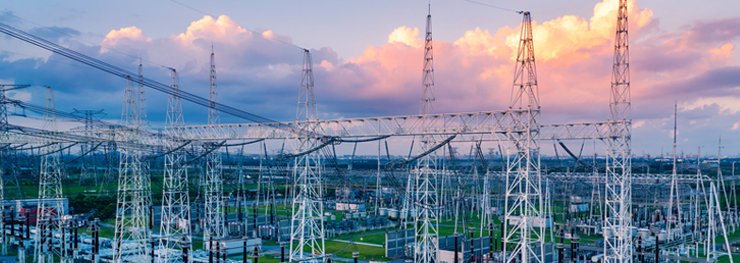
Your Network's Edge®
Blog Post
You are here
IoT for Next-Gen Substation Connectivity
The energy industry, as we know it, is changing. The digital era is pushing us to transform and be more efficient. This means it will not only use the current internet setup but also take advantage of internet technology and smart methods to create more efficient power networks for the future.
Power grids are evolving, connecting more renewable energy resources and, therefore, producing more electricity. Power grids rely on legacy and new-generation systems to monitor and control electricity flow effectively. The electricity flow comes from generation sites through transmission lines and into the distribution grid, all the way down to the smart meters in our homes, industries, and businesses. Digital systems are now being used throughout the grid and data must be exchanged to monitor quality, safety, and activate protection systems. Reliable and scalable communications are critical in handling information in real and near-real-time.
Substations are critical components of any electricity grid. They are used to transform high voltage into medium and low voltages. Additionally, they organize electrical lines to distribute power to local communities and urban areas efficiently. Moreover, they facilitate the onward transmission of power to other substations in the network. Substations exchange information in real-time regarding events that occur in different parts of the network. Therefore, data connectivity is essential in allowing that to happen. In addition, it must be secure, reliable, and have ultra-low latency to ensure real-time response time to malfunctions.
Furthermore, more bandwidth is required in communications systems for legacy and new-generation SCADA, IIoT, video/infra-red systems, cybersecurity, and scalability as new distributed energy resources (DERs) are constantly added and connected to the electricity grid.
Reduce Power Outages:
Receiving real-time data enables proactive grid management, which leads to fewer and shorter power outages. This is because it allows utilities and grid operators to monitor the electrical grid continuously. This means receiving information down to the latest millisecond regarding the grid’s performance. Hence, power companies can detect equipment failures, power overloads, or voltage fluctuations. They can then correct them before they escalate or cascade throughout the grid. This includes rerouting power, isolating faulty components, or deploying maintenance teams to address problems before they escalate into full-blown outages. (See also: Rad's robust utilities communication solutions)
Ultra-Low Latency:
Ultra-low latency allows data to be transmitted to different parts of the power grid with minimal delay. This includes SCADA, teleprotection, Industrial IoT sensor controllers, and data centers. Ultra-low latency is an essential part of monitoring, protecting, and controlling the power grid. When data arrives without delay, operators can take action faster as soon as the grid changes. Therefore, if there’s a surge in electricity consumption, such as during the first hot day in summer, or if high-voltage lines are down due to natural disasters, low latency ensures that the situation is solved before it causes a fault. Hence, the data and control signals reach almost instantly control centers and electricity is re-routed and re-connected in near real-time.
More Bandwidth:
Bandwidth is crucial as it assists the communications network to transmit large volumes of data quickly. The power grid requires high bandwidth to allow data to transfer smoothly and without issues. This includes streaming real-time sensor data, synchronized phasor meters connectivity, video and infrared/thermal surveillance, and analytics, which are critical for grid monitoring and management.
Cybersecurity:
Cyber-attacks are increasing due to the popularity of industries digitizing. Therefore, cybersecurity is paramount. It requires the correct measures in place to ensure data integrity and that operational systems are not hacked. However, most of all, ensuring that there is a constant flow of electricity. As a result, it's crucial to safeguard the data and communication infrastructure from potential breaches. This includes implementing encryption, authentication, intrusion detection, anomaly detection, and other security measures to prevent unauthorized access and ensure the integrity and confidentiality of grid data.
Scalability:
As the power grid evolves to cope with today's and tomorrow's energy needs, it must be able to scale effectively. This means incorporating more DERs, devices, sensors, and applications. The utilities' communication infrastructure should be able to adapt and expand.
This involves adding new communication nodes, increasing network capacity, and maintaining performance even as the grid's size and complexity increase. Studies suggest electricity transmission systems (TSOs) may grow by 60% by 2030. Growth allows support for renewable energy deployment and electrification of railway systems and electrical public and private transportation infrastructure and vehicles.
GOOSE time:
IEC 61850 GOOSE (generic object-oriented substation event) is the most common communication protocol for real-time information between different IEDs (intelligent electronic devices) located in the substation, over Ethernet links.
GOOSE messages are much more reliable and faster than traditional protocols. This is key, as some critical applications that are part of the electrical grid require that the delay will not exceed a few milliseconds. By meeting these requirements, GOOSE messages are ideal for protection schemes and automatic control systems. However, while IEC 61850 addresses communications within the substation, communications between power substations are also critical for the operation of the entire system.
Secure & Ruggedized Communications with Backup and Automation:
RAD’s SecFlow devices are ruggedized IEC 61850-certified gateways that are used to extend GOOSE communications over fixed WAN), as well as over 4G/5G to ensure continuous communication in case of a fiber network failure. SecFlow also functions as a multipath gateway to aggregate SSL tunnels, support load-sharing, and control message delivery to and between substations. Ensuring substation and data integrity and security with data encryption and advanced firewalls, it’s the ultimate solution for modern power systems to enable reliable and efficient communication, real-time monitoring, and effective management of the electrical grid.
Read more about how SecFlow enables Next-Gen substation connectivity here.

